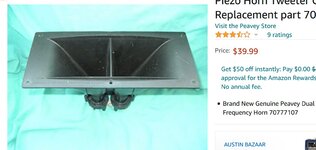LazerBeakShiek
Rad Racing Team
How do I control volume to each speaker in a 2 way 8 ohm 15"/ 4" horns PA cabinet. I want more wattage going to the 15" woofer than the 4" Driver horns. If I use a crossover with more than 4Khz -12 db per octave , that will not be the same. I want the horn frequencies, just not as loud. If there was only a volume knob for the horn speakers to separate the volume.
My ADA Bass amp has hi and low on a bi amplifier. A Vol nob for the 10" cab and a knob for the 15". They can be balanced out as needed.
That is kinda what I want for my PA. Is there a way to place a volume potentiometer before the speaker contacts on the horn? Could I turn them down some like that. Like a guitar vol knob.
How about a dummy load resistor placed in series just before the 4k crossover?
Like a 200 watt 8 ohm resistor on the horn wires. Would that drop the horn speakers 200 watts of PA volume compared to the woofer in the same cabinet? What am I looking for?
My ADA Bass amp has hi and low on a bi amplifier. A Vol nob for the 10" cab and a knob for the 15". They can be balanced out as needed.
That is kinda what I want for my PA. Is there a way to place a volume potentiometer before the speaker contacts on the horn? Could I turn them down some like that. Like a guitar vol knob.
How about a dummy load resistor placed in series just before the 4k crossover?
Like a 200 watt 8 ohm resistor on the horn wires. Would that drop the horn speakers 200 watts of PA volume compared to the woofer in the same cabinet? What am I looking for?


